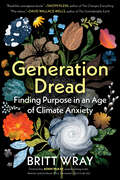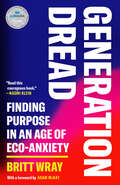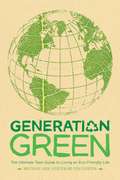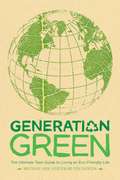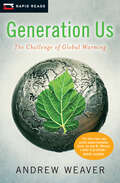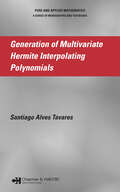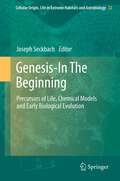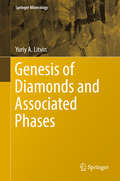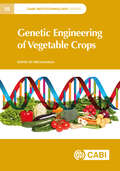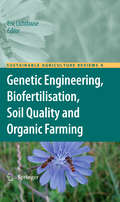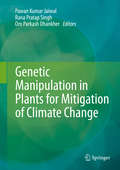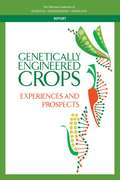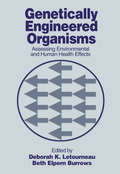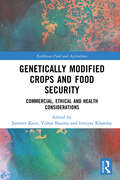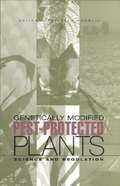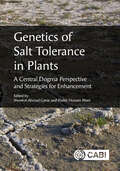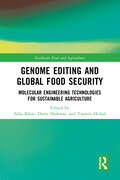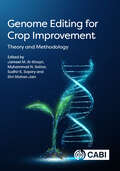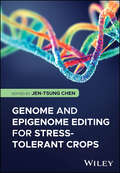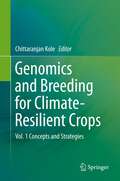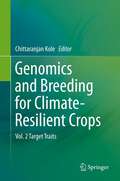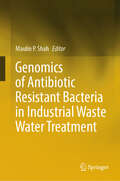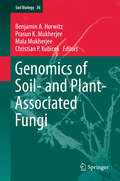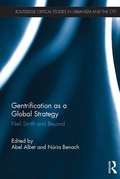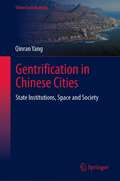- Table View
- List View
Generation Dread: Finding Purpose In An Age Of Climate Anxiety
by Britt Wray“Generation Dread is a vital and deeply compelling read.”—Adam McKay, award-winning writer, director, and producer (Vice, Succession, Don’t Look Up) “Read this courageous book.”—Naomi Klein, author of This Changes Everything “Wray shows finally that meaningful living is possible even in the face of that which threatens to extinguish life itself.”—Dr. Gabor Maté, author of When the Body Says No When we’re faced with record-breaking temperatures, worsening wildfires, more severe storms, and other devastating effects of climate change, feelings of anxiety and despair are normal. In Generation Dread, Britt Wray reminds us that our distress is, at its heart, a sign of our connection to and love for the world. The first step toward becoming a steward of the planet is connecting with our climate emotions—seeing them as a sign of our humanity and empathy and learning how to live with them. Britt Wray, a scientist and expert on the psychological impacts of the climate crisis, brilliantly weaves together research, insight from climate-aware therapists, and personal experience, to illuminate how we can connect with others, find purpose, and thrive in a warming, climate-unsettled world.
Generation Dread: Finding Purpose in an Age of Climate Crisis
by Britt WrayFINALIST FOR THE GOVERNOR GENERAL'S LITERARY AWARDA CBC BEST CANADIAN NONFICTION BOOK OF 2022AN INDIGO TOP TEN BEST SELF-HELP BOOK OF 2022"A vital and deeply compelling read.&” —Adam McKay, award-winning writer, director and producer (Don&’t Look Up)&“Britt Wray shows that addressing global climate change begins with attending to the climate within.&” —Dr. Gabor Maté, author of The Myth of Normal"Read this courageous book.&” —Naomi KleinAn impassioned generational perspective on how to stay sane amid climate disruption.Climate and environment-related fears and anxieties are on the rise everywhere. As with any type of stress, eco-anxiety can lead to lead to burnout, avoidance, or a disturbance of daily functioning. In Generation Dread, Britt Wray seamlessly merges scientific knowledge with emotional insight to show how these intense feelings are a healthy response to the troubled state of the world. The first crucial step toward becoming an engaged steward of the planet is connecting with our climate emotions, seeing them as a sign of humanity, and learning how to live with them. We have to face and value eco-anxiety, Wray argues, before we can conquer the deeply ingrained, widespread reactions of denial and disavowal that have led humanity to this alarming period of ecological decline.It&’s not a level playing field when it comes to our vulnerability to the climate crisis, she notes, but as the situation worsens, we are all on the field—and unlocking deep stores of compassion and care is more important than ever. Weaving in insights from climate-aware therapists, critical perspectives on race and privilege in this crisis, ideas about the future of mental health innovation, and creative coping strategies, Generation Dread brilliantly illuminates how we can learn from the past, from our own emotions, and from each other to survive—and even thrive—in a changing world.
Generation Green
by Linda Sivertsen Tosh SivertsenWe all know about the Earth's environmental crisis, but there is someone who can truly make a difference: you. If you text your friends or chat with them online, download music to your iPod, or toss bottles and papers into recycling bins, you're already more eco-savvy than you think. It's just as easy to do even more to help save the earth, and Generation Green shows you how. This book: Lays out the inside scoop on the biggest issues affecting our planet, such as global warming and overflowing landfills * Offers dozens of tips on how to shop, dress, eat, and travel the green way * Includes interviews with teens like you who are involved with fun, innovative green causes * Shows that being environmentally conscious can be a natural part of your life -- and your generation's contribution to turning things around. It doesn't matter if you can't vote or drive. Your efforts -- big or small -- will contribute to saving the planet. It's time for all of us to take action. It's time to go green!
Generation Green: The Ultimate Teen Guide to Living an Eco-Friendly Life
by Linda Sivertsen Tosh SivertsenWe all know about the Earth's environmental crisis, but there is someone who can truly make a difference: you. If you text your friends or chat with them online, download music to your iPod, or toss bottles and papers into recycling bins, you're already more eco-savvy than you think. It's just as easy to do even more to help save the earth, and Generation Green shows you how. This book lays out the inside scoop on the biggest issues affecting our planet, such as global warming and overflowing landfills. Offers dozens of tips on how to shop, dress, eat, and travel the green way. Includes interviews with teens like you who are involved with fun, innovative green causes. Shows that being environmentally conscious can be a natural part of your life -- and your generation's contribution to turning things around. It doesn't matter if you can't vote or drive. Your efforts -- big or small -- will contribute to saving the planet. It's time for all of us to take action. It's time to go green!
Generation Us: The Challenge of Global Warming (Rapid Reads)
by Dr. Andrew J. WeaverIn clear and accessible language, Generation Us explains the phenomenon of global warming, outlines the threat it presents to future generations and offers a path toward solutions to the problem. The reality of global warming has long been accepted within the scientific community, yet it remains a hotly debated topic at the political and social level. Why is this? Is it the fact that the ultimate effects of global warming will not be felt in our lifetimes? Do we really feel no moral responsibility for future generations? Dr. Weaver, one of the world's leading experts in the field, contends that, just as humans have been responsible for creating the problem of global warming, we must also be the solution.
Generation of Multivariate Hermite Interpolating Polynomials
by Santiago Alves TavaresThis text advances the study of approximate solutions to partial differential equations by formulating a novel approach that employs Hermite interpolating polynomials and by supplying algorithms useful in applying this approach. The book's three sections examine constrained numbers, Hermite interpolating polynomials, and selected applications. The authors outline the rules for writing the algorithms and then present them in pseudo-code. Next, they define the properties that characterize the Hermite interpolating polynomials, propose an expression and demonstrate an algorithm for generating the polynomials, and show the advantages of this new technique over the classical approach.
Genesis - In The Beginning
by Joseph SeckbachGenesis - In The Beginning deals with the origin and diversity of Life and early biological evolution and discusses the question of where (hot or cold sources) and when the beginning of Life took place. Among the sections are chapters dealing with prebiotic chemical processes and considering self-replication of polymers in mineral habitats. One chapter is dedicated to the photobiological regime on early Earth and the emergence of Life. This volume covers the role of symmetry, information and order (homochrial biomolecules) in the beginning of Life. The models of protocells and the genetic code with gene transfer are important topics in this volume. Three chapters discuss the Panspermia hypothesis (to answer "Are we from outer Space?"). Other chapters cover the Astrobiological aspects of Life in the Universe in extraterrestrial Planets of the Solar System and deal with cometary hydrosphere (and its connection to Earth). We conclude with the history and frontiers of Astrobiogy.
Genesis of Diamonds and Associated Phases (Springer Mineralogy)
by Yuriy A. LitvinThis book presents an overview of recent advances in our understanding of the genesis of diamonds and the associated phases. It is divided into three main parts, starting with an introduction to the analysis of diamond inclusions to infer the formation processes. In turn, the second part of the book presents high-pressure experimental studies in mantle diamond-parental mineral systems with representative multicomponent boundary compositions. The experimental syngenesis phase diagrams provided reveal the physicochemical mechanisms of diamond nucleation and substantiate the mantle-carbonatite concept of the genesis of diamonds and associated phases. Lastly, the book describes the genetic classification of diamond-hosted mineral inclusions and experimentally determined RE “mineral-parental melt” partition coefficients. The physicochemical experimental evidence presented shows the driving forces behind the fractional evolution of the mantle magmas and diamond-parental melts.Given the depth and breadth of its coverage, the book offers researchers essential new insights into the ways diamonds and associated minerals and rocks are naturally created.
Genetic Engineering of Vegetable Crops (CABI Biotechnology Series)
by Pritam KaliaConventional plant breeding alone can no longer sustain the rising global demand for food. Genetic engineering technology makes it possible to develop new crop varieties with improved yield performance, specific quality attributes (external and internal in vegetable crops), resistance to diseases and insect pests, and environmental stresses. Genetic engineering technology for developing GM crops is complementary to genome editing and other breeding technologies. In addition to food requirements, transgenic crops have the possibility to carry edible vaccines and therapeutic proteins, to help combat human disease and malnutrition. This book reviews the importance and safety of transgenic vegetable crops and covers a wide variety of crops and different technologies. It includes: Genetic engineering in tomato, eggplant, peppers, amaranth, cauliflower, carrot, cucurbits, potato, tropical tubers and melons. Transgenic resistance to viral diseases. Embryogenic cell suspension culture. Genome editing and CRISPR/Cas9. Molecular techniques for biofortification. RNAi strategies for vegetable crop improvement. Designing futuristic vegetable crop varieties. This book is suitable for researchers in horticulture, plant science, and agricultural biotechnology as well as practitioners in vegetable breeding and seed production.
Genetic Engineering, Biofertilisation, Soil Quality and Organic Farming
by Eric LichtfouseSustainable agriculture is a rapidly growing field aiming at producing food and energy in a sustainable way for humans and their children. Sustainable agriculture is a discipline that addresses current issues such as climate change, increasing food and fuel prices, poor-nation starvation, rich-nation obesity, water pollution, soil erosion, fertility loss, pest control, and biodiversity depletion. Novel, environmentally-friendly solutions are proposed based on integrated knowledge from sciences as diverse as agronomy, soil science, molecular biology, chemistry, toxicology, ecology, economy, and social sciences. Indeed, sustainable agriculture decipher mechanisms of processes that occur from the molecular level to the farming system to the global level at time scales ranging from seconds to centuries. For that, scientists use the system approach that involves studying components and interactions of a whole system to address scientific, economic and social issues. In that respect, sustainable agriculture is not a classical, narrow science. Instead of solving problems using the classical painkiller approach that treats only negative impacts, sustainable agriculture treats problem sources. Because most actual society issues are now intertwined, global, and fast-developing, sustainable agriculture will bring solutions to build a safer world. This book series gathers review articles that analyze current agricultural issues and knowledge, then propose alternative solutions. It will therefore help all scientists, decision-makers, professors, farmers and politicians who wish to build a safe agriculture, energy and food system for future generations.
Genetic Manipulation in Plants for Mitigation of Climate Change
by Om Parkash Dhankher Pawan Kumar Jaiwal Rana Pratap SinghThis book presents a detailed overview and critical evaluation of the state of the art and latest approaches in genetic manipulation studies on plants to mitigate the impact of climate change on growth and productivity. Each chapter has been written by experts in plant-stress biology and highlights the involvement of a variety of genes/pathways and their regulation in abiotic stress, recent advances in molecular breeding (identification of tightly liked markers, QTLs/genes), transgenesis (introduction of exogenous genes or changing the expression of endogenous stress- responsive genes) and genomics approaches that have made it easier to identify and isolate several key genes involved in abiotic stress such as drought, water lodging/flooding, extreme temperatures, salinity and heavy-metal toxicity. Food and nutritional security has emerged as a major global challenge due to expanding populations, and cultivated areas becoming less productive as a result of extreme climatic changes adversely affecting the quantity and quality of plants. Hence, there is an urgent need to develop crop varieties resilient to abiotic stress to ensure food security and combat increased input costs, low yields and the marginalization of land. The role of GM crops in poverty alleviation, nutrition and health in developing countries and their feasibility in times of climate change are also discussed. Recent advances in gene technologies have shown t he potential for faster, more targeted crop improvements by transferring genes across the sexual barriers. The book is a valuable resource for scientists, researchers, students, planners and industrialists working in the area of biotechnology, plant agriculture, agronomy, horticulture, plant physiology, molecular biology, plant sciences and environmental sciences.
Genetically Engineered Crops: Experiences and Prospects
by Engineering Medicine National Academies of SciencesGenetically engineered (GE) crops were first introduced commercially in the 1990s. After two decades of production, some groups and individuals remain critical of the technology based on their concerns about possible adverse effects on human health, the environment, and ethical considerations. At the same time, others are concerned that the technology is not reaching its potential to improve human health and the environment because of stringent regulations and reduced public funding to develop products offering more benefits to society. While the debate about these and other questions related to the genetic engineering techniques of the first 20 years goes on, emerging genetic-engineering technologies are adding new complexities to the conversation. Genetically Engineered Crops builds on previous related Academies reports published between 1987 and 2010 by undertaking a retrospective examination of the purported positive and adverse effects of GE crops and to anticipate what emerging genetic-engineering technologies hold for the future. This report indicates where there are uncertainties about the economic, agronomic, health, safety, or other impacts of GE crops and food, and makes recommendations to fill gaps in safety assessments, increase regulatory clarity, and improve innovations in and access to GE technology.
Genetically Engineered Organisms: Assessing Environmental and Human Health Effects
by Deborah K. Letourneau Beth Elpern BurrowsGenetic engineering suggests new avenues for constructing useful products, but it also poses hazards to the health of the environment and the public. Delineating those hazards is complicated, difficult, and important at every level of risk assessment and risk management decision-making. Risk assessment and risk management may be further complicated
Genetically Modified Crops and Food Security: Commercial, Ethical and Health Considerations (Earthscan Food and Agriculture)
by Vishal Sharma Jasmeet Kour Imtiyaz KhandayThis book reviews a wide-range of genetically modified (GM) crops to understand how they are produced, the impacts on the agricultural industry, and their potential for improving food security. The production of GM crops has now become an invaluable asset in the agricultural toolbox. With a significant portion of the world suffering from hunger and poverty, this book examines how food security can be achieved through GM crops. A wide variety of crops are examined, from the earliest developments of GM tomatoes and potatoes to recent interest in the development of low-cost, high yielding biofuels, such as microalgae. Chapters also discuss the role of GM crops in pest management and the consequential reduction in the use of insecticides. Overall, this book provides an important synthesis of GM crops from their commercial value to the agricultural industry, as well as their potential for improving food security. This book will be of great interest to students and scholars of agricultural engineering, crop science, food biotechology, food security, and those interested in food and agriculture and sustainable development more broadly.
Genetically Modified Pest-protected Plants: Science And Regulation
by National Research CouncilThis book explores the risks and benefits of crops that are genetically modified for pest resistance, the urgency of establishing an appropriate regulatory framework for these products, and the importance of public understanding of the issues.The committee critically reviews federal policies toward transgenic products, the 1986 coordinated framework among the key federal agencies in the field, and rules proposed by the Environmental Protection Agency for regulation of plant pesticides. This book provides detailed analyses of: Mechanisms and results of genetic engineering compared to conventional breeding for pest resistance. Review of scientific issues associated with transgenic pest-protected plants, such as allergenicity, impact on nontarget plants, evolution of the pest species, and other concerns. Overview of regulatory framework and its use of scientific information with suggestions for improvements.
Genetics of Salt Tolerance in Plants: A Central Dogma Perspective and Strategies for Enhancement
by Kehinde A. Adeboye Victor J. Bamisaye Farwa Basit Usman Rabi’u Bello Javaid Akhter Bhat Jamindar Buddiga Utpal Das Balasundari Dharbaranyam Xianzhong Feng M. Gayathri Abubakar Mohammad Gumi Md Sazzad Hossain Emmanuel O. Idehen Krishnananda P. Ingle Nancy McMulkin Mushtaq Ahmad Najar Oyeboade A. Oyetunde Kapil Patil Britta Pitann Shiva Sai Prasad Fergie Ann Quilloy Md Zillur Rahman J. R. Rajeshwar P. W. Ramteke Hamza Ramzan Vincent Pamugas Reyes Kausalya Sakthivel Palanisamy Senthilmurugan Usama Sheraz Sajid Shokat Pradeep Kumar Shukla Atul Singh Gayatri Venkataraman Mst Ishrat ZahanGene expression in cells follows a prescribed pathway that conforms to the Central Dogma; where the genetic information stored in DNA is transcribed into RNA and then expressed into proteins, which influences most plant traits. Plant salt tolerance research is directed towards identifying nucleotide variants that could contribute to tolerant phenotypes. This book comprehensively presents the current state of knowledge on plant salt tolerance through meticulous analysis of the processes operating across the Central Dogma. It provides a detailed account of modulation of gene expression through genome editing systems to achieve crop improvement against salt stress. It also provides state-of-the-art information on advances in breeding technologies of genome selection and accelerated de novo domestication for rapidly improving the salt tolerance of plants for global food security. This book: 1.Provides a comprehensive coverage of plant salt tolerance mechanisms. 2.Spotlights various factors functioning along the Central Dogma pathway and their regulation in response to salinity. 3.Examines how these factors function to protect the plants from high salinity. 4.Highlights advances in cutting-edge breeding technologies for improving salt tolerance. The book will be of particular value to students and researchers of plant genetics, molecular biology and physiology and those with an interest in salinity and salt tolerance.
Genome Editing and Global Food Security: Molecular Engineering Technologies for Sustainable Agriculture (Earthscan Food and Agriculture)
by Zeba Khan Durre Shahwar Yasmin HeikalWith the rapid increase in the global population and changing climatic impacts on agriculture, this book demonstrates how genome editing will be an indispensable technique to overcome ongoing and prospective agricultural challenges. This book examines the role of genome editing in improving crop yields and contributing to global food security. It summarizes a range of genome editing techniques and discusses the roles they can play in producing a new generation of high-yielding, climate-ready crops. This includes site-specific nucleases, precision genome engineering, clustered regularly interspaced short palindromic repeats, and bioinformatics. It showcases how these gene editing techniques can tailor plants to not only increase yield-related traits but to also make them better suited to their environment and to be resistant to pests and extreme climatic events, such as droughts. The book also examines genome editing regulations and policies, the commercialization of genome-edited crops, and biosafety and biosecurity concerns. Overall, this book reveals and showcases how genome editing can improve crop resilience and production to address current and future agricultural challenges and alleviation of global food security concerns. This book will be of great interest to students and scholars of agricultural science, crop and plant science, genome editing, sustainable agriculture, biotechnology, and food security.
Genome Editing for Crop Improvement: Theory and Methodology
by Shri Mohan Jain Jameel M. Al-Khayri Muhammad N. Sattar Sudhir K. SoporyGenome editing offers a powerful tool to significantly accelerate crop-breeding programs in order to develop new and improved varieties. It allows precise modification of an organism's DNA sequence, often by creating targeted double-strand breaks at specific locations. The CRISPR-Cas system has emerged as the preferred method of gene editing and offers a powerful technology for crop improvement. The use of CRISPR in plant research has led to significant improvements in crop performance in terms of yield, nutrition, stress tolerance and resistance against agricultural pests and diseases. This book explores the cutting-edge field of genome editing, its applications and potential to revolutionize the genetic improvement of crops. It includes: Foundational concepts and historical context of genome editing (GE). Structure and mechanisms of various genome editing techniques. Application of GE for trait improvements in plants. Regulatory, biosafety, and ethical considerations. This is a valuable resource for researchers in crop genetic improvement, graduate and postgraduate students in molecular biology and biotechnology programs, and professionals in the field.
Genome and Epigenome Editing for Stress-Tolerant Crops
by Jen-Tsung ChenProvides a timely overview of the use of CRISPR and non-coding RNA technologies to develop climate-resilient crops With mounting challenges from climate change, expanding populations, and resource limitations, the need for resilient and sustainable agricultural systems has never been greater. Genome and Epigenome Editing for Stress-Tolerant Crops summarizes advanced techniques for creating crops that can withstand both biotic and abiotic stressors. Edited by renowned biologist Jen-Tsung Chen, this authoritative volume discusses the coordination of CRISPR/Cas technology with ncRNA-based epigenetics to enhance stress tolerance and improve crop quality. In addition to offering insights into genetic and molecular advances, contributions by experts in the field present key methodologies and applications that bridge multiple omics technologies with genome editing for impactful agricultural outcomes. Addressing emerging tools and strategies that could be instrumental in achieving the United Nations Sustainable Development Goals (SDGs) and advancing sustainable agriculture, Genome and Epigenome Editing for Stress-Tolerant Crops: Provides an in-depth overview of CRISPR/Cas and non-coding RNA strategies to develop stress-tolerant crops.Integrates multiple omics approaches, including genomics, transcriptomics, and metabolomics for comprehensive crop improvement.Discusses strategies for resilience against both abiotic and biotic stressors, such as drought, salinity, pests, and pathogens.Offers practical applications of CRISPR and RNA technologies for high-yield, high-quality crop development.Presents recent research advancements in epigenetic regulation to fine-tune plant stress responses.Discusses future directions in plant science to inspire new research and experimental designs. Genome and Epigenome Editing for Stress-Tolerant Crops is essential reading for advanced undergraduate and graduate courses in plant biology, molecular genetics, and agricultural biotechnology. It is also a valuable reference for researchers, plant breeders, and scientists working on crop improvement and climate-resilient agriculture initiatives.
Genomics and Breeding for Climate-Resilient Crops
by Chittaranjan KoleClimate change is expected to have a drastic impact on agronomic conditions including temperature, precipitation, soil nutrients, and the incidence of disease pests, to name a few. To face this looming threat, significant progress in developing new breeding strategies has been made over the last few decades. The first volume of Genomics and Breeding for Climate-Resilient Crops presents the basic concepts and strategies for developing climate-resilient crop varieties. Topics covered include: conservation, evaluation and utilization of biodiversity; identification of traits, genes and crops of the future; genomic and molecular tools; genetic engineering; participatory and evolutionary breeding; bioinformatics tools to support breeding; funding and networking support; and intellectual property, regulatory issues, social and political dimensions.
Genomics and Breeding for Climate-Resilient Crops: Vol. 2 Target Traits
by Chittaranjan KoleClimate change is expected to have a drastic impact on agronomic conditions including temperature, precipitation, soil nutrients, and the incidence of disease pests, to name a few. To face this looming threat, significant progress in developing new breeding strategies has been made over the last few decades. The second volume of Genomics and Breeding for Climate-Resilient Crops describes various genomic and breeding approaches for the genetic improvement of the major target traits. Topics covered include: flowering time; root traits; cold, heat and drought tolerance; water use efficiency; flooding and submergence tolerance; disease and insect resistance; nutrient use efficiency; nitrogen fixation; carbon sequestration; and greenhouse gas emissions.
Genomics of Antibiotic Resistant Bacteria in Industrial Waste Water Treatment
by Maulin P. ShahThis book discusses the key problems and solutions with various applicable approaches to combat antibiotic-resistant genes in industrial waste water. Several genes are selected within the chapters to illustrate the past and future roles of molecular ecophysiology and genomics in the development of wastewater microbiology as an important subdiscipline of microbial ecology. As we have very limited knowledge of composition, dynamics and stability of microbial communities, various processes in wastewater treatment have been generally considered to be "black box." In recent years, with the development of several new high throughput sequencing platforms, metagenome sequencing strategies and bioinformatics toolboxes, the analysis of the genome of complex communities has become much more accessible and means easier.The opening of the biological wastewater treatment “black box” is not the unpleasant experience it was before. The viable, but not cultural, ceases to be the inconsequential, uncharacterizable enigma that existed today. Metagenomics leads the way for more specific studies in related fields. Finally, genomic studies of wastewater treatment microbes, in addition to their biotechnological applications, are also an excellent testing ground for variety of other ecological and environmental burns questions. Wastewater treatment plants are considered hotspots for the environmental dissemination of antimicrobial-resistant determinants. Comparative genomics of antibiotic resistant genes isolated from conventional activated sludge and biological aerated filter wastewater treatment plants is discussed.
Genomics of Soil- and Plant-Associated Fungi
by Christian P. Kubicek Mala Mukherjee Prasun K. Mukherjee Benjamin A. HorwitzThis volume addresses the similarities and also the differences in the genomes of soil saprophytes, symbionts, and plant pathogens by using examples of fungal species to illustrate particular principles. It analyzes how the specific interactions with the hosts and the influence of the environment may have shaped genome evolution. The relevance of fungal genetic research and biotechnological applications is shown for areas such as plant pathogenesis, biomass degradation, litter decomposition, nitrogen assimilation, antibiotic production, mycoparasitism, energy, ecology, and also for soil fungi turning to human pathogens. In addition to the model organisms Neurospora and Aspergillus, the following species are covered providing a view of pathogens and mutualists: Trichoderma, Fusarium oxysporum, Cochliobolus heterostrophus, Penicillium chrysogenum, Rhizopus oryzae, Podospora anserina, Agaricomycetes, Archaeorhizomycetes and Magnaporthaceae. Ecology and potential applications have guided the choice of fungal genes to be studied and it will be fascinating to follow the trends of future sequencing projects.
Gentrification as a Global Strategy: Neil Smith and Beyond (Routledge Critical Studies in Urbanism and the City)
by Abel Albet Núria BenachThis book pays homage to Neil Smith’s ideas, offering a critical approach and rich collection of insights that draw on Smith’s work for inspiration and debate. With interdisciplinary and international contributions from leading experts, the book demonstrates the impact of Smith’s ideas on understanding the role of urbanisation in general and gentrification, in particular, in contemporary society. The book demonstrates how gentrification varies significantly from city to city, across different cultural and political-economic regimes, and in terms of the timing of urban transformations. This collection provides a forum for debate for those working in urban regeneration and citizenship, and those directly affected by the processes and problems arising from gentrification. It will be of interest to students and scholars in urban geography, urban sociology, cultural studies, and wider social and urban theories.
Gentrification in Chinese Cities: State Institutions, Space and Society (Urban Sustainability)
by Qinran YangThis book provides an institutional interpretation of state-facilitated gentrification in Chengdu, an emerging central city of China. It generalizes the three aspects of institutional changes in the cultural, economic and social spheres that have thus far directed the operation of gentrification in the transitional economy: the creative destruction of consumption spaces, the spatial production of excess, and the unequal redistribution of spatial resources to low-income residents. The interactions of state and society, are examined in navigating the institutional changes and forming the Chinese distinctions of gentrification. The author argues that these three aspects of institutional changes characterize gentrification in Chengdu as a transformative force of development led by the state and capitalists and championed by middle-class consumers. This gentrification mode periodically catalyzes new spaces and collective cultures, which then necessitate the stimulation of new consumption behaviors and the formation of new consumer classes, at the expense of the spatial demands for the even larger number of low-income residents. However, in the context of China's unique state–society relations, some low-income groups may also ride the wave of social transformation. The author suggests that this type of gentrification integrates into not the essence of uneven geographical development in a capitalist society, but China’s unique model of urbanization and development, which is often state-driven, innovative and even involuted so as to sustain continuous growth. Though the research is focused on urban China, this book also contributes to methodological issues on gentrification research on a global scale. It is skeptical both of the structural explanation and of the revelation of unsorted differences; instead, it aims to generate midrange regularities of gentrification in Chinese cities. Institutional change is treated as an intermediary that, on the one hand, responds to the global trends and, on the other hand, adapts to local preconditions. Mixed methods, including statistical and spatial analysis, institutional analysis, and an extensive ethnographic study, are used to investigate gentrification from a structural perspective, a historical perspective, and as a grounded process within the locality.
